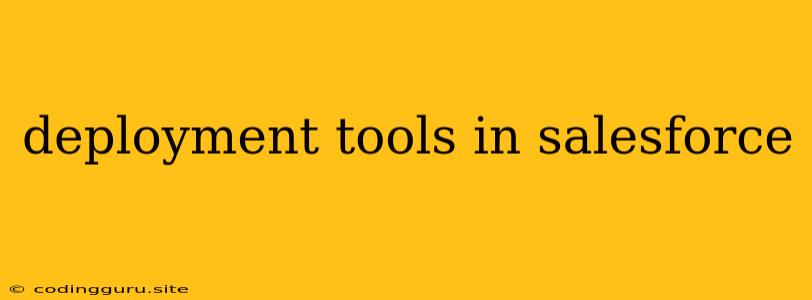Deployment Tools in Salesforce: A Comprehensive Guide
Salesforce is a powerful and versatile platform that allows businesses to streamline their operations and enhance customer relationships. As your Salesforce implementation grows, managing changes, updates, and configurations can become a complex and time-consuming task. This is where deployment tools come in. They simplify the process of moving changes between different Salesforce environments, ensuring a smooth and efficient transition.
Why are deployment tools essential?
- Reduce manual errors: Manually copying and pasting code or configurations can lead to errors and inconsistencies. Deployment tools automate this process, minimizing the risk of human error.
- Streamline development cycles: Deployment tools allow developers to work in separate development environments, reducing conflicts and improving efficiency.
- Enhance collaboration: By centralizing code and configurations, deployment tools foster collaboration among development teams and stakeholders.
- Maintain version control: Deployment tools track changes made to your Salesforce instance, allowing you to roll back to previous versions if necessary.
- Improve testing and quality assurance: Deployment tools facilitate the process of testing changes in staging environments before deploying them to production, ensuring code quality and user satisfaction.
Types of Deployment Tools:
There are various deployment tools available for Salesforce, catering to different needs and preferences. Here are some of the most popular options:
1. Salesforce CLI (Command Line Interface):
This is a free and open-source tool that allows you to interact with your Salesforce org using command-line commands. It offers a range of capabilities, including:
- Source version control: You can manage your Salesforce code and configurations using Git or other source control systems.
- Deployment automation: Salesforce CLI enables you to automate deployment processes, such as pushing changes from development to production environments.
- API access: It provides access to the Salesforce API, allowing you to build custom integrations and scripts.
2. Ant Migration Tool:
This is a Java-based tool that has been widely used for Salesforce deployments for many years. It offers features like:
- Batch deployment: You can deploy multiple components in a single operation.
- Selective deployment: Choose which components to deploy, avoiding unnecessary changes.
- Rollback functionality: Revert deployments if needed.
3. Gearset:
This is a popular commercial deployment tool that offers a user-friendly interface for managing your Salesforce deployments. Its key features include:
- Visual deployment: View the changes you are about to deploy before committing.
- Advanced comparison tools: Easily identify differences between environments.
- Sandbox management: Manage and configure your Salesforce sandboxes effectively.
- Integration with other tools: Seamlessly integrate with popular tools like Jira and Slack.
4. Copado:
This is another commercial deployment tool that provides a comprehensive solution for managing Salesforce deployments. Its features include:
- Automated deployments: Automate deployments to different environments.
- Release management: Plan and manage releases effectively.
- Quality management: Ensure code quality through automated testing and code analysis.
- Integrations: Connect Copado with other popular tools like Jira and Git.
Choosing the Right Deployment Tool:
Selecting the right deployment tool depends on your specific needs and resources. Consider factors like:
- Budget: Salesforce CLI is free, while other tools may come with subscription fees.
- Technical expertise: Salesforce CLI requires more technical knowledge, while other tools might be more user-friendly.
- Team size and complexity: For large teams and complex projects, a more comprehensive deployment tool might be necessary.
- Integration requirements: Choose a tool that integrates well with your existing workflow and tools.
Tips for Effective Deployment:
- Establish clear deployment processes: Define how changes are made, tested, and deployed.
- Use staging environments: Test changes in staging environments before deploying to production.
- Automate deployments: Use deployment tools to automate as much as possible, reducing manual work.
- Monitor deployments: Track deployment progress and resolve issues promptly.
- Regularly review and update your deployment strategy: As your Salesforce implementation evolves, adapt your deployment processes to meet changing needs.
Conclusion:
Deployment tools are essential for managing and streamlining changes in your Salesforce instance. By automating deployments, reducing errors, and improving collaboration, they empower you to optimize your development processes and ensure a smooth transition of changes across different environments. Whether you choose Salesforce CLI, Ant Migration Tool, Gearset, Copado, or another solution, the key is to select a tool that fits your team's technical expertise, budget, and project requirements. By adopting the right deployment tools and establishing best practices, you can streamline your Salesforce development workflow and maximize the value of your Salesforce investment.
